





’HANDS OFF’ PROTESTERS GATHER IN ARVADA P2


















’HANDS OFF’ PROTESTERS GATHER IN ARVADA P2











BY SUZIE GLASSMAN SGLASSMAN@COLORADOCOMMUNITYMEDIA.COM

in its 12th year, the contest invites students to create original snowboard graphics for a semester-long design challenge.
one of the school’s most celebrated collaborations.



ARVADA WOMEN’S GROUP GATHERS SUPPLISE FOR THOSE IN NEED P4 SPRING CLEANING TIPS TO GET THINGS IN SHAPE P10

When CJ Walter, a senior in Je co’s graphic design program at Warren Tech, stepped on stage and saw their design, “Beyond the Horizon,” printed on a full-size snowboard for the rst time, they couldn’t stop smiling.
“I’m so incredibly proud of everything I’ve accomplished with it,” Walter said.
Walter’s board was among 10 selected in the annual snowboard design contest hosted by Warren Tech Central and Denver-based Never Summer Industries. Now
e winning designs are printed on snowboards produced by Never Summer and awarded to students during a spring ceremony.
e contest began in 2013 after Pete Cunis, one of Warren Tech’s graphic design instructors, brought a group of students to tour Never Summer’s factory. During the visit, he reconnected with former colleague Vince Sanders, Never Summer’s chairman, and proposed an idea that quickly became
“We had this moment where we thought, what if we gave students the opportunity to design a real snowboard?” Cunis said. “And Never Summer was totally on board.”
From sketches to snowboards
Since then, the partnership has grown into a comprehensive, year-long design project that begins each fall with a classroom visit from Never Summer sta .
BY RYLEE DUNN RDUNN@COLORADOCOMMUNITYMEDIA.COM
Middle schoolers from Excel Academy in Arvada got to take a trip to Arizona for an immersive science experience, dubbed a “Mission to Mars,” which included a visit to Biosphere 2, a research facility that features a simulation landscape of Mars’ surface.
irty-one sixth-graders, four parent chaperones and two faculty members were able to go on a four-day eld study from Feb. 25 to 28. is was Excel’s second year sending students to the desert for science camp, a change that was ushered in because of changes to science standards in Colorado.
e trip began at the Arizona-Sonora Desert Museum, followed by a visit to
Biosphere 2 and a trip to Colossal cave Mountain Park, where students explored geological formations and learned about the cave’s history. A visit to the Flandrau Space Center and Planetarium followed, with festivities concluding at the Titan Missile Museum for a look at Cold War history.
National movement to display dissent with current administration shows presence in Arvada
BY RYLEE DUNN RDUNN@COLORADOCOMMUNITYMEDIA.COM
About 400 Arvadans gathered at the Grandview Avenue overpass to voice their disapproval with President Donald Trump’s administration as part of a national e ort to demonstrate against the executive branch.
e Hands O protests drew an estimated 3 million people at 1,400 locations across all 50 states on April 5, according to the BBC.
e Arvada contingent displayed signs featuring slogans such as “Hands o our future,” “Tari s spark revolutions — light this re,” and “Defend democracy,” and heard honks of approval from passing cars throughout the day.
“I am tired of being sad and being mad about what is going on in our country, and this has helped me so much to come out and actually do something,” one protester, who held an “Impeach” sign and wished to remain anonymous, said. “And do it with no malice, just wanting to put my voice out there.”
Pat Malone, a member of Arvadans for Progressive Action, said her organization helped get the word out about the Hands O protest.
“It was thinking, ‘We really need to start doing something in Arvada,’ ” Malone said. “We’re big enough, and there’s a lot of interest. I said, ‘You know what, this weather looks awful, let’s do Arvada.’” Malone said that over 180 people have joined the group since the presidential election. e organization was started in 2016 and has over 700 members








Second round features two external candidates, current deputy city manager
BY RYLEE DUNN
Arvada is zeroing in on its next city manager once more, hosting the second group of nalists for a public meet and greet on April 10 at Arvada City Hall.
e city has been without a permanent city manager since the departure of Lorie Gillis last year.In January, the city hosted three di erent nalists and decided against o ering the job to any of them, instead going back to the drawing board and restarting the candidate search. Deputy City Manager Linda Haley has been serving as acting city manager since last July.

e nalists this time around are Robert “Bob” Cowell, who most recently served as the city manager of Roanoke, Virginia; Larry Dorr, who currently serves as deputy city manager for Westminster; and Don Wick, who is Arvada’s other deputy city manager and has previously served as the city’s police chief and director of public works.


sonnel issues that arose with other city sta members, according to Virginia local news outlet Cardinal News. Before that, Cowell was the deputy city manager in Amarillo, Texas.
“What attracted me to Arvada, from what I’ve been able to learn about the community, is that the mayor, the (city) council are all aligned in understanding what the challenges are that are in front of them, and the opportunities as well,” Cowell said. “ ey’re very interested in that same thing — doing the best for their residents and their businesses.”
Cowell holds degrees from St. Louis University and the University of Tennessee, and is also a Certi ed Urban Planner.
Larry Dorr
e meet and greet is scheduled for 4 to 6 p.m., April 10, at 8101 Ralston Road. City council will interview candidates the next day, April 11, according to Arvada’s Director of Communications Rachael Kuroiwa.
Robert “Bob” Cowell Cowell spent about seven years as the city manager of Roanoke, Virginia, before he resigned following several per-
For the past ve years, Dorr has served as deputy city manager for Westminster, and worked as the nance director for the City of Lakewood for 16 years before that. He credits his familiarity with the local community as something that makes him a strong candidate.
Last Friday, CNN reported on a survey by the University of Michigan about consumer confidence, which showed a significant decline — 30% since December 2024.
“This decline was, like the last month’s, pervasive and unanimous across age, income, education, geographic region and political affiliation,” Joanne Hsu, the survey’s director, said in a release.
According to CNN, “the Federal Reserve and Wall Street are watching closely how souring sentiment translates into consumer spending, which accounts for about 70% of the US economy, and whether Americans lose faith that inflation will return to normal in the coming years.”
Sales are continuing to rise, and an increasing number of sellers are putting their homes on the MLS. Here are statistics for the previ-
can vary significantly. Here’s that chart:
measure of both seller hopes versus what the market will bear.

ous seven days (as of last Friday):
New listings — 1,425

That decline is consumer sentiment is not yet reflected in real estate statistics which I researched on REcolorado, Denver’s MLS. The charts shown in this report are for the 13 months from March 2024 through March 2025, so that you can see both year-over-year and month-over-month changes.
Coming soon — 90
Price reductions — 1,466
Under contract — 932
Withdrawn from MLS — 95
Back on Market — 198
Expired without selling — 153
Closed — 589
This is not an easy time to list and sell a home, and I would describe it as a “buyer’s market.” Even in a buyer’s market, however, keep in mind that a home which is priced correctly and has appealing qualities can sell quickly and even be in a bidding war.
How fast? Here’s the change in months of inventory and median days on the MLS:

The blue line is the asking price per square foot, and the green line is the sold price per square foot. In December, that price was bid up, but since then it has fallen, which is a
April statistics will be available in time for my column on May 8th. Since the greatest political and economic disruption is happening this month, it will be interesting to see how this month’s real estate activity is affected by current “externalities.” If you’re interested in my thoughts about those, you’ll want to check out my political blog, which is at http://TalkingTurkey.substack.com
The financial gap between purchasing a home and renting a home or apartment has grown significantly, making the dream of homeownership more distant, according to a report released by Redfin last Thursday.
According to the report, the typical American now needs to earn over $116,600 annually to afford a median-priced home in the U.S., compared to just $64,160 needed to afford an average apartment. That’s an 81.1 percent income gap — the widest it has been in recent years.

Homes are still being put on the MLS and are still selling. I limited my analysis to an 18-mile radius of downtown Denver, as shown in the map at right, not the “metro area” defined by county boundaries, as preferred by the Market Trends Committee of REcolorado.
First I looked at the count of active versus closed listing by month:


At the current rate of sales, it would take 3 months to sell the number of currently active listings, but the median days on market fell from over 40 in January to 17 in March.
Meanwhile, the average and median sold prices have remained steady. Average is always higher because of the number of million dollar homes sold.

I like to look at the change in price per finished square foot, since the size of homes

Those are national statistics, however. Here in the Denver metro area, the differential is much higher — 131.7 percent — according to Redfin. It takes an income of $155,717 to afford a median-priced home ($580,719) and $67,200 to afford a medianpriced apartment ($1,680 per month). That’s a year-over-year income increase of 4% for buying and a 1.1% decrease for renting. That reflects the national pattern of increased differential between the affordability of buying versus the affordability of renting.
The income needed to afford the typical home is calculated using the prevailing median home sale price and average mortgageinterest rate over rolling three-month periods, and assumes a 15% down payment. The typical housing payments noted in Redfin’s report include the mortgage principal, interest, property taxes, homeowners’ insurance and mortgage insurance.
The income needed to afford the typical apartment is calculated using the prevailing median asking rent over rolling three-month periods. Median asking rent figures cover newly listed units in apartment buildings with five or more units. Asking rents reflect the current costs of new leases during each time period. In other words, the amount shown as the median asking rent is not the median of what all renters are paying, but the median asking price of apartments that were available for new renters during the report period.
Redfin considers a home affordable if a buyer spends no more than 30% of their income on their housing payment. They use the same threshold for rental affordability.
The San Francisco Bay Area had the highest income differentials in the Redfin study. In San Jose, someone needs an annual income of $408,557 to afford the typical home for sale. That’s 218% more than they need to afford the typical apartment for rent—the biggest premium among the metro areas which Redfin analyzed. Next came San Francisco (176%), Seattle (145%), Austin (143%) and Los Angeles (141%).
Cincinnati saw the biggest drop in the homebuying premium. There someone needs an annual income of $80,752 to afford the typical home for sale. That’s 38.9% more than they need to afford the typical rental. A year ago they would have needed to earn 47.7% more to buy versus rent.
Back in February, I announced that our truck needed a new engine and other repairs and that we decided to retire it instead. This was a big loss to such non-profits as Operation Feed the Troops, Family Promise, BGoldN, Christian Action Guild, Buffalo Bill Days, and the International Rescue Committee, among others, which used the truck more often than our clients!
The truck is off the road but still available to be repaired. So far, we’ve received about $1,500 in donations. If you’d like to contribute, visit www.BringItBack.info. Thanks!







Local sorority chapter gathers menstrual products for underprivileged women
BY RYLEE DUNN RDUNN@COLORADOCOMMUNITYMEDIA.COM
LuWanda Ford held a ziplock bag open as she walked down the table at King of Glory Lutheran Church.
She paused at various charitable stations, picking up a week’s supply of tampons, pads and hand sanitizer, carefully placing them inside. e bags would go to women who cannot a ord menstrual products — ful lling one of Community Table’s biggest needs.
Ford is a member of the Laureate Beta Iota chapter of the Beta Sigma Phi sorority — a non-academic, non-religious national women’s group that has roots in Arvada going back at least 20 years.
While Beta Sigma Phi’s local chapter’s membership numbers have dwindled in recent years — Laureate Beta Iota only has seven members — Ford said they are still looking for ways to do good in the local community. e idea for “period packs” came from a Beta Sigma Phi sister of Ford’s in her original chapter, which was in Virginia.
“I went to visit her and they had a women’s project at church where they were putting packs together to send to Africa,” Ford said. “And I said, ‘ at’s such a neat
idea, but we need it here.’ And the idea has just kind of germinated for close to a year.
“And when I presented it to my chapter, and I said, ‘ is is something I talked to the Community Table, they have the need for the items; they had a means to distribute them,” Ford continued.
Leanne Cadman, Community Table’s chief communications o cer, said that menstrual products are something the nonpro t “never gets enough of.”
“ ere’s a huge need in the community for that,” Cadman said. “It’s something that’s really hard to come by and is super expensive, usually, for people.”
Ford invited members of other Beta Sigma Phi chapters and members of the community — including Arvada Mayor Lauren Simpson — to the period packmaking event, which saw 16 people get together and make 236 completed bags and 96 nearly completed bags, the latter of which will be nished up and donated to Community Table soon, Ford said. e packs each contain regular and super tampons, sanitary napkins and hand sanitizer, and in some cases hand soap.
Ford said that she felt it important to help ensure that everyone in the community has access to menstrual products.
“For the students, they don’t go to school if they don’t have period products,” Ford said. “For women who are unhoused or who can’t a ord them, maybe they can’t go to work, maybe it ruins their clothing. It’s just hard for me to imagine not having the necessary products.”

Now, Beta Sigma Phi is setting its sights on expanding membership, while also continuing to help the community.
“We want to support women,” Ford said. “We encourage women. When young women come in, they learn to speak in front of a small group presenting
a program. ey learn to work together on committees and teams. ey learn to organize. ey build friendships that last a lifetime.”
Ford said women interested in joining Beta Sigma Phi can email revivebsp@ gmail.com or visit bspinternational.org.





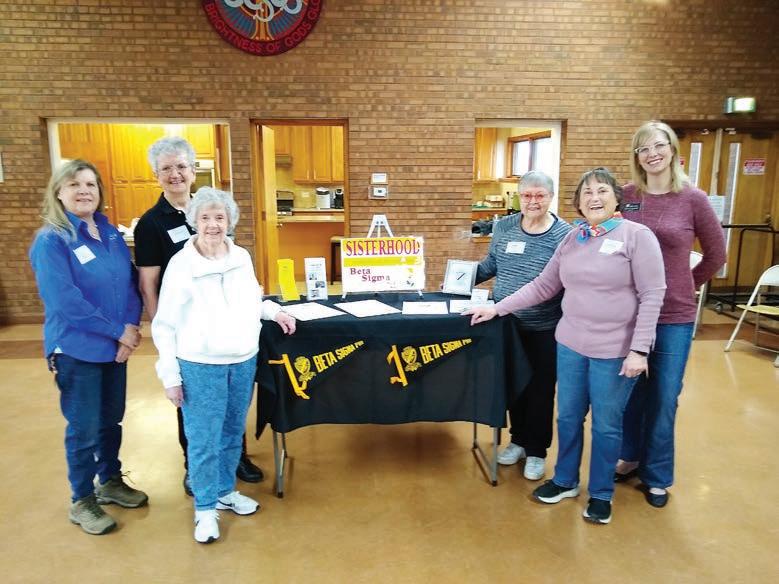



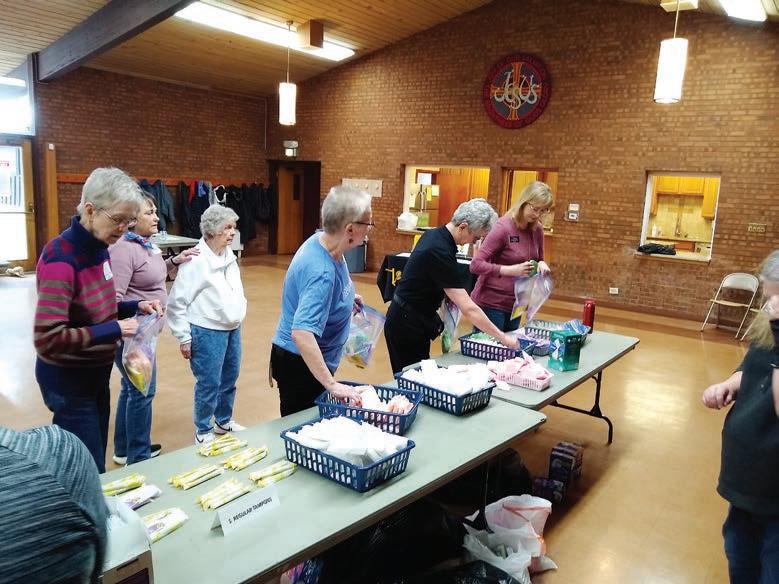





























Excel Academy Principal Kresta Vuolo said the trip was jammed packed.
“It was actually very incredible; we had a fabulous time,” Vuolo said. “We learned a lot, and we were going nonstop. We started waking students up at about 5:45 a.m. each morning, and we were typically in our vans to head to our rst excursion location by 7:30 a.m. each morning.
“ en, we were returning after dinner in the evenings to do our re ections on the day and journal entries in preparation for work that the students were going to do when they got back to school,” Voulo continued.
Voulo also said the students packed
boxes at Community Food Bank of Southern Arizona — putting together a total of 1,398 boxes. She said the trip was a great opportunity for students to practice self su ciency.
“ e other bene t of the extended eld studies is developing independence, developing con dence, developing the ability to manage one’s own luggage, they’re managing choices they make for their meals,” Voulo said. “ ey’re managing a lot of those independent things that help them as they grow into young adults.”
e students have continued learning about the topics studied during the trip. Students completed learning albums that will eventually get turned in for a grade, and elements of the trip’s curriculum have been incorporated into the student’s science class for the rest of the year.


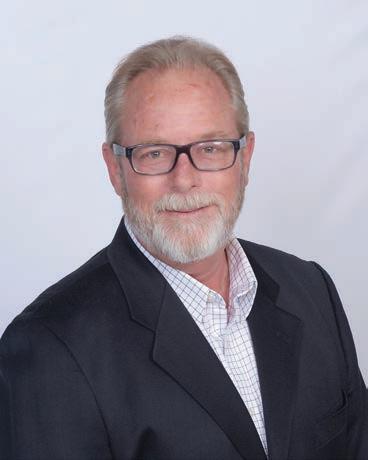





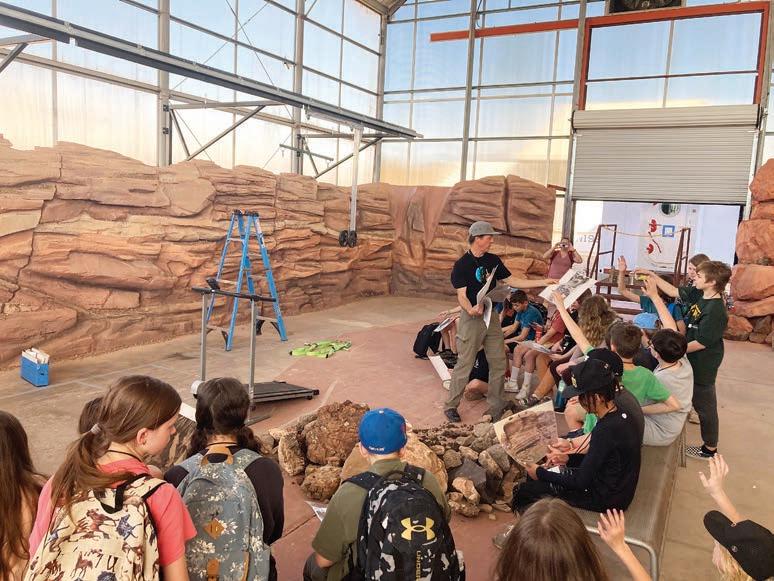


Leaders at local companies say they just want some accurate information
BY TAMARA CHUANG THE COLORADO SUN
As yet another round of higher tari s began and then were paused, Sandi Moilanen over at the World Trade Center was certain about one thing.
“Right now, the biggest need is accurate information, not speculative information,” Moilanen said. “Our role is to disseminate information … and help them cut through the noise.”
e local World Trade Center’s client base tends to be small-to-midsize companies trying to navigate the world of global trade. Building a manufacturing plant in the United States isn’t a nancial possibility. Many already searched for a closer manufacturer but due to the high cost to make goods here or the specialized nature of their products, the search sent them to other countries where they found a way to build on their business.
World Trade Center sta found themselves responding to the same questions for the past several days — were the new tari s in addition to existing ones (yes, in most cases), what countries added retaliatory tari s (sta can pull that up for clients) and what are ways to minimize fees (foreign trade zones might be an option).
But nding answers in an ever-evolving trade war has been challenging with the abrupt policy switcharoos. Reciprocal tari s of up to 50% started April 9, before President Donald Trump changed course and said around noon that day that he was lowering reciprocal tari s to 10% on all countries for 90 days except for China.
Importers of goods made in China now face an even higher tari of 125% after China retaliated and matched every increase Trump put on Chinese imports. And it’s not how tari s were rolled out in the past. Countries typically target an industry or product, such as earlier U.S. tari s on solar panels or China’s tari s on soybeans. “ is is a new approach, the blanket approach,” she said.
To help all businesses keep track of what may be happening, the organization set up a special tari page on its website. e chart doesn’t spell out exact tari s by country; rather, it points to the source and original documents so people can read it for themselves to determine the impact on their business.
Importing from China: Plan A to Plan F “ e biggest thing we can be doing is pointing to the resources that are the accurate implementation of what this all means,” Moilanen said.
When outdoor clothing company Krimson Klover set its prices on its Fall 2025 line of sweaters in October, the tari on imports from China was 7.5%. e Trump admin-


istration added another 10% in February (“Plan A,” Chief Operating O cer Gail Ross said), then another 10% in March (“Plan B”) and since then, several more iterations due to a tit-for-tat trade war with China have ensued.
“So now we’re at 27.5% (in March), so that’s Plan C. en we got an additional 34%, that was Plan D and well, yesterday, we were up to 104%, so now that’s Plan E,” said Ross on Wednesday. “And now it’s 125%. We have not gured out Plan F yet.”
In other words, imported goods from China that are valued at $1 million now face a tari at U.S. Customs of $1.25 million. e company has put trade shows, marketing and travel on hold.
She wishes the sweaters could be made in America, but she said there’s no “high-end Merino sweater production in the U.S.” or at least a manufacturer willing to take the order of the 13-employee Boulder company.
“Our option is not to bring us back to the States. It could be if the U.S. government would work with factories, make small business loans and help them really get, not just seamstresses because it’s not that kind of machine, but knitters,” Ross said. “ en you still need people who link the panels together. e point is if we want sweaters back in the States, that’s a ve- to 10-year plan. at is not an overnight plan because it doesn’t exist here.”
Fixing a trade imbalance
Trump’s policies are an attempt to reduce the nation’s $36.2 trillion debt and address a trade imbalance. It’s causing all sorts of business chaos but what if it mends what’s wrong with global trade, asked Dan Caruso, managing director of investment rm Caruso Ventures who has long supported and invested in local companies.
“Why do you go to Europe and not see any cars that were produced in the U.S.? Is it that the U.S. doesn’t know how to produce cars (or) because if you want to sell a U.S. car in Europe, good luck. e VAT taxes are way too high and the prices are way too inappropriate,” Caruso said. “We’re not starting with a level playing eld. … People produce goods here in the U.S. and they’ve had to deal with unfair trade practices. We’ve been kind of complacent. ey might be overdoing it now but we’re tackling it now.”
But he also understands that CEOs can’t run a business with so much uncertainty.
ey’re facing di cult decisions, such as whether to raise prices, lay o sta or slow down investments.
“ ese are very real issues that a ect people’s lives,” he said. “But I’m trying to put that in perspective with if we just let the status quo continue, which is what happened whether it’s been a Republican or Democrat administration for the last 20 years, this unfair trade practice. Now we’ve got people trying to do something about it. Should we at least try to understand it better before we throw a bunch of mud at it?”
Whether or not company leaders are aligned with one political side or others, the uncertainty makes running a business dif-




A publication of


Colin McIntosh, founder of sustainable bedding company Sheets & Giggles, in a photo taken in 2024 at Mile High Workshop, a Denver organization that provides assembly and manufacturing services.
cult. Even top business leaders have complained about the economic disruption, including Republicans and Trump supporters, Elon Musk and his brother Kimbal.
Earlier this week, U.S. Rep. Je Hurd, a Republican from Grand Junction, signed on to a bipartisan bill that seeks to place the role of setting and approving U.S. trade policy in the hands of Congress, not the executive branch.
“As a constitutional conservative, I am proud to co-lead the Trade Review Act of 2025, reasserting our congressional responsibility in imposing tari s,” Hurd said in a written statement. “ is isn’t a political issue for me. I believe Congress must reclaim its constitutionally mandated authority, and I would support this measure regardless of who is in the White House.”
U.S. House Speaker Mike Johnson, R-Louisiana, has all but stopped the measure in its tracks using parliamentary maneuvers. It was always unlikely to pass the Republicancontrolled Congress.
Colorado’s economy has bene ted from imports and exports. e value of imports grew in the pandemic as many consumers cut down on travel, gas and other expenses and put their money into home renovation and online shopping. While it’s declined since peaking in 2022, Colorado’s import value is still above where it was before the pandemic, up 28% since 2019 to $16.8 billion last year, according to U.S. Census trade data.
Colin McIntosh, founder of sustainable bedding company Sheets & Giggles, has been concerned about the tari s since the new administration began.
SEE TARIFF, P17

Tiny (307850) is a 2½-year-old male cat. His former owner describes him as an independent kitty who enjoys attention on his own terms and can be quite playful but also is content to keep himself entertained. Tiny is reassured by other friendly felines and came in with several, including Clever (307848). Kitty pairs from the group can be adopted for a shared fee.



Call first: 3540 Evergreen Parkway, Evergreeen, CO, 80439
Mailing Address: 750 W. Hampden Ave., Suite 225 Englewood, CO 80110
Phone: 303-566-4100
ArvadaPress.com
To subscribe call 303-566-4100 or Scan this QR Code

BROOKE WARNER Executive Director brooke@ntln.org
LINDA SHAPLEY Director of Editorial & Audience lshapley@coloradocommunitymedia.com
ERIC HEINZ West Metro Editor eric@cotln.org
RYLEE DUNN Community Editor rdunn@coloradocommunitymedia.com
ERIN ADDENBROOKE Marketing Consultant eaddenbrooke@coloradocommunitymedia.com
LINDSAY NICOLETTI Operations/ Circulation Manager lnicoletti@coloradocommunitymedia.com
BUSINESS INQUIRIES For advertiser or vendor questions, please email our business department at accounting@ coloradocommunitymedia.com
Columnists & Guest Commentaries Columnist opinions are not necessarily those of the Press. We welcome letters to the editor. Please include your full name, address and the best number to reach you by telephone. Email letters to letters@coloradocommunitymedia.com Deadline Tues. for the following week’s paper.
Arvada press A legal newspaper of general circulation in Je erson County, Colorado, the Arvada Press is published weekly on Thursday by Colorado Community Media, 3540 Evergreen Parkway, Evergreen, CO 80439.
POSTMASTER: Send address change to: Arvada Press, 750 W. Hampden Ave., Suite 225, Englewood, CO 80110













Colorado Trust for Local News asks readers to make us aware of mistakes we may have made.
Email linda@cotln.org if you notice a possible error you would like us to take a look at.


We have two dogs that are best friends. ree-year-old Skye and one-year-old Bear are Coltrievers, part Golden Retriever and part Border Collie. Technically, they are aunt and nephew; Bear’s mother was born in the same litter as Skye.
As soon as 9-week-old Bear joined our family, Skye started trying to get him to play with her; so incredibly happy to have a playmate. What began as a fullgrown dog trying to coax a timid weeksold puppy into doing a little bit of running around has evolved into full-on races inside and outside of the house where you will often hear Beth or I exclaim, “Hey, now that’s too rough.”
e games of these two best friends are a joy to watch. ey might start with Skye squeaking a toy four or ve times or Bear patting the ground and pretending to jump forward.
e language of these two is amazing to watch in action. e invitation to playtime is followed by a mix of wagging tails, panting tongues, playful growling, lots of running and un ltered joy. eir rumpus room friendship has this dear, quiet side, too. Last week, I was sitting at the table doing some work, and these two best friends lay on top of my feet with their heads touching each other. As I watched that sweet, tender moment, I could not help but think about the role friends play in our lives.
e collective power of friendship is astounding. In the history of humankind friendship has altered the course of en-



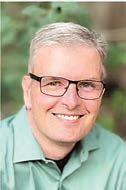
tire nations, been the foundation for business empires, and the impetus for lifechanging discoveries and inventions.
Friendships make our individual days richer and provide us with avenues for laughter and lifetime memories. ey present us opportunities to share our deepest secrets and a shoulder to cry on in times of greatest need. Friendships are one of our world’s most precious resources. Nurturing a friendship reaps amazing rewards for each of us.
When a friend faces challenging life events, it can leave us searching for the perfect way to help. We know how much that friendship adds to our lives, and we want to be that same type of support for our friend. We see their pain and their need, and we want to be the di erence makers. Most of us will, at some point, face questions about how to support our friends in their moment of need.
Here is what I have learned so far about those moments when you want to help but don’t know how:
• Be consistent, a force of positivity they can trust will be present.
• Listen so you understand the needs of the person struggling.
• Give help on the timeline of the person needing help.


• Be authentically yourself, lean into your strengths when you are trying to gure out how to help.
• Distance, being 5 minutes or 5,000 miles apart, is not a barrier friends feel. Act when your friend needs it. is week I hope you will celebrate the friends you have. ey are incredible encouragers, some of your greatest treasures and they deserve your best.
I would love to hear about the friendships that have made a di erence in your life.
After World War II, Americans came home and began building one of the world’s best economies.
Our soldiers took advantage of the GI Bill which helped pay for education and housing. ey married their sweethearts and moved into the new homes that were being built. As U.S. car production resumed, they bought a car and took one of the many new jobs being created by the wildly expanding American economy. As the wartime economy transformed into a peacetime one you might call it the Golden Age of American Capitalism.


Jim Roome lives in Arvada with his wife Beth. He spent 34 years in public education. Lessons learned from the one two punch of being diagnosed with MS shortly before his best friend was diagnosed with terminal cancer led him into a new pursuit as a freelance writer and speaker. He uses his life experiences and love of stories to inspire, educate and encourage local, national and international audiences. Contact him at jim.roome@gmail. com.
e Golden Age continued into the ‘50’s as America’s GNP more than doubled between 1945 and 1960. One of our economy’s successes were the thousands of small manufacturers serving both consumer and industrial needs. By 1954 there were approximately 344,000 manufacturing establishments in the U.S. One of those in my hometown was a small company that made thermometers. It employed between 100 and 150 employees. My father was a sales and marketing executive for this company. In our town of about 75,000 there were a dozen or so similar sized companies making a variety of products or machine parts. ese small manufacturers were scattered around the country and were especially common in the Midwest. My dad’s company, like the others, treated employees well in terms of pay and bene ts. I well remember when I was about to go o to college, my dad was given a

raise to cover the annual cost of college. e companies were loyal to their employers and the employees returned the loyalty with hard work.


In the seventies things began to change. Owners who were now of retirement age looked for a business sale opportunity to fund their retirement. As ownership changed from founding families to competitors or larger companies in companion businesses, the smaller business was often shut down. As this happened again and again, thousands of jobs were lost.
At the same time, larger manufacturers began to utilize robotics and other labor-saving strategies. Over 3.5 million industrial robots are currently operating in factories worldwide (according to the International Federation of Robotics). e United States has some of the highest labor costs globally, particularly in the manufacturing sector. According to the U.S. Bureau of Labor Statistics (BLS), in 2016, the average hourly compensation cost in U.S. manufacturing was $39.03. is gure is higher than in many other industrialized countries, such as the United Kingdom ($26.96), Japan ($25.37), and Korea ($15.58).
As the U.S. has navigated through the changing business realities, the products o ered have changed from manufacturing to services like, banking, insurance,
legal and many others. We will likely not be well positioned to see the manufacturing sector rise to the happy days of the 50’s.
As of the latest data, manufacturing employment in the United States comprises approximately 8.3% of the total workforce. is re ects a signicant decline from previous decades; for instance, in 1990, manufacturing accounted for about 16.3% of total U.S. employment. Despite this decrease, the manufacturing sector remains a crucial component of the U.S. economy, contributing $2.93 trillion to the economy, which is 10.0% of U.S. GDP as of the third quarter of 2024.
e current idea of using tari s to bring back manufacturing to America seems unlikely to succeed. We are part of a world economy, and we must compete to succeed. In its nal days, the small thermometer company lacked the know how to produce digital thermometers. Each time I spy a round dial thermometer, I strain to see if it is an Ohio ermometer, If so, a tear comes to my eye. Mr. President, thanks for trying to bring back the happy days. If you could, I would gladly trade for my computer and phone.
Jim Rohrer of Evergreen is a business consultant and author of the books “Improve Your Bottom Line … Develop MVPs Today” and “Never Lose Your Job … Become a More Valuable Player.” Jim’s belief is that common sense is becoming less common. More about Jim at www.theloyaltypartners.com.




The Revolutionary War began in April 1775 at the Battle of Lexington and Concord. After the Shot Heard Round the World, there could be no compromise. e American rebellion either had to be crushed, or it had to succeed. Twenty months into the war, omas Paine wrote it was a time that tried men’s souls. e situation was grim. e Continental Army was back on its heels, but that didn’t deter those ghting for their rights. ey sti ened their resolve and remained resolute.
Today, many Americans are back on their heels. e country is in a period of disrepair with anxiety enveloping the nation. Faith and trust in major institutions has declined. Algorithms of tech giants, like Meta, condition users’ brains to salivate like Pavlov’s dogs when hearing a bell. Predatory private equity groups drive costs up for consumers by sucking the blood from upstarts and small businesses. e wealth gap is inexorably widening. e top 10% control 69% of American wealth and the bottom fty percent a mere six percent. Many work multiple jobs trying to make ends meet.
ose dependent upon Social Security, Medicare, Medicaid, and Veterans’ bene ts are terri ed as the Grim Reaper wields his scythe. ere are those who say we haven’t been through a time like this one. But we’ve been at the brink before. Nonetheless, I get it. is era seems like a mutant pathogen compared to our previous turbulent periods. It’s seriously worrisome no matter what one’s political persuasion is.
Citing examples from our past, however, doesn’t assuage the fear that we’re currently facing extreme threats and crises. Far from it. It just gives evidence that we’re never completely safe and that our wellbeing and rights cannot be taken for granted. It takes ongoing vigilance and work to protect and ensure them. at begins with not self-sabotaging and ceding personal power. But many continue to do just that and then feel hapless and helpless when doo-doo hits the fan. I fear that we’re evolving into automatons. We’re being so conditioned, anesthetized even, by the fast-and-easy MO of modern life — think fast food, Facebook, and cell phones—that we’re becoming mechanistic. e result is that cynicism has become a social mindset. ere’s more than one problem with that beginning with cynicism being antithetical to the human condition. A primary tenet of cynicism is an I-cando-it-alone mentality, but we’re a social, co-dependent species. It’s bad enough to lose faith and trust in institutions; it’s quite another to lose them in each other, our fellow citizens. If that happens, it will lead not only to personal and societal dysfunction but also be injurious to, even lethal for, our democracy.
Henry Wadsworth Longfellow memorialized the Battle of Lexington and
Colorado Community Media welcomes letters to the editor. Please note the following rules:
• Email your letter to letters@coloradocommunitymedia.com. Do not send via postal mail. Put the words “letter to the editor” in the email subject line.
• Submit your letter by 5 p.m. on Wednesday in order to have it considered for publication in the following week’s newspaper.
• Letters must be no longer than 400 words.
• Letters should be exclusively submitted to Colorado Community Media and should not
“ e reason I’m interested in serving as the Arvada city manager is I see an Arvada that’s an exciting community with engaged residents and business owners that has a really rich history,” Dorr said. “I see a city that has incredible potential and a very bright future. I see the challenges that are present in the community as an opportunity to overcome, and make Arvada even better.
“I believe that my skills and experience getting results would be impactful, and I believe that by working closely with Arvada excellent city sta , we can drive the city’s continued success,” Dorr continued.
Dorr is a licensed CPA and has over-
Concord in his epic poem, “Paul Revere’s Ride.” I smilingly recall reading the poem aloud with my eighth graders. e poem is loosely accurate with details, but it isn’t about facts. It’s about feelings. Afterward, I’d give them time to sketch their thoughts and feelings. ey got it. eir artwork expressed it vividly. I fear, though, that some if not many of them have lost that “loving feeling” now that they’re middle aged, the time when disillusionment can set in.
I admit to experiencing disconsolate moods, which I’ve shared with a few. It helps to vent, but it doesn’t help if what is being vented becomes gelled into a mindset. If I feel that happening, I give myself a good shake. Because that’s not who I am or wish to be.
Every good leader knows if you go into a fray feeling defeated, you’ll assuredly lose. But if you set your jaw, understanding the battle could be a protracted slog, you’ll have more than a chance. You will win.
Saturday, April 19, 2025, will be the semiquincentennia l—250th — anniversary of the Battle of Lexington and Concord. It’ll be a perfect day to commemorate, celebrate, and muse upon what our ancestors did to allow us the privilege of being a free, feisty people. I encourage you to pull up and slowly read Longfellow’s poem aloud. And especially take to heart the poem’s last two stanzas.
Before the Battle of Agincourt, the king in “Henry V” states, “All things be ready if our minds be so.” By that he’s saying although his army is militarily girded for battle, victory will depend on its mental and emotional state. at’s true today. If everyday Americans follow their ancestors’ lead and act with resolve and resolution, they can change the nation’s socio-economic trajectory to ensure equity and opportunity not for those for whom enough is never enough but for themselves, the heart, brain, brawn, and soul of America. ey can, that is, if their minds be so.
submitted to other outlets or previously posted on websites or social media. Submitted letters become the property of CCM and should not be republished elsewhere.
• Letters advocating for a political candidate should focus on that candidate’s qualifications for o ce. We cannot publish letters that contain unverified negative information about a candidate’s opponent. Letters advocating for or against a political candidate or ballot issue will not be published within 12 days of an election.
seen projects such as the Belmar Downtown redevelopment and the development of St. Anthony’s Hospital.
Don Wick
e only internal candidate of the bunch, Wick served as an Arvada Police O cer for over 30 years, eventually rising through the ranks to become the city’s chief of police. Wick credits his familiarity with Arvada as something that makes him a good candidate.
“I’m interested in becoming the city manager because Arvada isn’t just where I work; this is my home,” Wick said. “ is is where I live, where I’ve built my family. I have built lasting relationships with many community members, our city team and regional partners. Arvada has an exceptional leadership team and team members throughout all of our city departments.








































Discover tips for a fresh start from local experts
BY ISABEL GUZMAN ISABEL@COTLN.ORG
As the days grow longer and da odils bloom, the arrival of spring brings more than just warmer weather. Pollen levels rise and dust bunnies hop around long after Easter.
Consequently, people emerge from winter hibernation to declutter closets and scrub oorboards with the start of the new season, marking the start of spring cleaning season.
While it is currently spring only in the northern hemisphere, multiple cultures across the globe are linked to spring cleaning.
One of the earliest references of the practice is generally acknowledged in the Jewish observance of Passover, which typically occurs in March or April, and lasts for about a week.
During this time, homes are cleaned to remove chametz — leavened grains like wheat or barley — symbolizing their swift departure from Egypt, when they couldn’t wait for the bread to nish baking.
In preparation for Good Friday and Easter Sunday, Catholic churches undergo thorough cleanings on Maundy ursday, exhibiting puri cation and readiness for the sacred days ahead.
Celebrated in March, Nowruz, which means “new day” in Persian, includes kh ne-tak n or “shaking the house,” where families deep-clean their homes to




sweep away the past and welcome new beginnings. In ailand, Songkran, which is a two-day festival in April, marks the ai New Year with the cleaning of homes and public spaces. Water plays a central role as people splash it on each other and Buddha statues to cleanse bad luck and invite blessings.
Known as “death cleaning,” Sweden’s philosophy, Döstädning, involves decluttering possessions to simplify life and ease burdens — a practical approach that conveys letting go of things that are no longer needed. Döstädning isn’t limited to a certain time of the year, but is rather instilled as a lifestyle.
Spring cleaning has remained a tradition for many, and local experts around the Denver metro area are weighing in with tips and tricks to tidy a home inside and out.
Health benefits
Spring cleaning isn’t just about aesthetics — it also o ers tangible health bene ts:
• Reduces allergens like pollen, mold and dust mites.
• Eliminates bacteria and viruses that can cause illness.
• Improves indoor air quality by removing pollutants.
• Decreases stress by creating a clean, organized environment.
• Enhances safety by reducing clutter that could cause trips or falls.






Tree pollen is a signi cant allergen during Colorado’s springtime, with elm, cottonwood, oak and maple trees being common culprits, according to Wyndly, an allergy-based healthcare company.
Pollen counts tend to be highest midday and evening, leaving the morning as the only time when outdoor allergens are at their lowest counts and the best time to ventilate homes, said Ryan Buckley, a doctor at Colorado Allergy & Asthma Centers.
For the indoors, Buckley recommends cleaning with products that are free of dyes and fragrances and using the minimum amount possible.
“Some over-the-counter cleaning products can irritate the airways,” he said. “If you are particularly sensitive to cleaning products, ventilate the area while cleaning.”
Buckley warned that making at-home cleaning solutions should be done cautiously, and advised against mixing vinegar and bleach as it can produce a hazardous chlorine gas.
Buckley also emphasized the importance of installing the correct air lter grade in central HVAC systems to trap allergens e ectively.
“If appropriate, consider running the system on ventilation mode periodically — for example, 15 minutes every one hour — to help move air through the lter and facilitate allergen removal, (and) replace lters as recommended by the manufacturer,” he said.
Buckley recommends placing a dehumidi er in bathrooms or basements that tend to be high in humidity levels, which can contribute to mold growth. He said indoor humidity levels should ideally be 40 to 50%, and added that anything lower can be too drying and aggravate allergy symptoms.
“If despite e ective cleaning e orts, you continue to have allergy symptoms, it is a good idea to undergo an allergy evaluation by a board-certi ed allergist,” Buckley said. “ ere are a variety of treatment options from over-the-counter medications to prescription therapies, including allergen immunotherapy. If needed, allergy testing can help identify potential triggers and better guide therapy to help you remain symptom-free.”
Dedicating a whole day to this season’s deep cleaning is how some decide to tackle the tasks, while others prefer to break it up over multiple days.
MaidPro, a cleaning company that has locally owned and operated businesses around Denver’s metro area, says on its website that breaking it up “is perfect for homeowners with busy schedules who can’t commit to an entire day of cleaning” but adds that “you must stay committed and ensure you don’t slack o toward the end of your spring cleaning.”
Many say that organization is key to e cient spring cleaning. ey include Cody Galloway, co-
founder of TULA, a service that helps “create more balance in life.”
By completing clients’ to-do lists — such as laundry, grocery shopping, meal planning and home organization — TULA came out of necessity to help clients who are inundated by life’s tasks, Galloway said.
“You stare at your endless to-do list while being stretched very thin at both work and at home and think, ‘there has to be a better way,’” she said. “So, we made one.”
TULA was founded in 2020 in Denver and has since spread its services to Boulder and Aspen, in addition to out-of-state locations, including Texas, Virginia, Arizona, Montana and North Carolina.
Galloway said TULA has a clientele that consists of busy parents and professionals, and anyone who just needs an extra set of hands.
Prioritizing deep-cleaning and decluttering tasks can be di cult, so Galloway recommends starting with the most overwhelming areas rst.
“If looking at your closet makes you break out in a cold sweat, that’s the place to start,” she said. “Tackle one category at a time — clothes, then shoes, then accessories — so you don’t end up sitting on the oor reminiscing over an old concert T-shirt or your painting overalls for two hours.”
Galloway recommends that spring cleaners invest in label makers and clear bins to organize the home.
“If you can’t see what’s inside, you’ll forget it exists,” she said.
While organizing, Galloway said implementing the “one-year rule” mindset is essential: “If you haven’t used it in a year, it’s time to part ways,” she said.













“ONE-YEAR RULE. IF YOU HAVEN’T
Cody Galloway, co-founder of TULA
Clothing, accessories and other donations can be made to local Goodwills and Arc rift Stores, and family-owned stores such as 2nd Time Around rift in Aurora. e thrift store opened in 2020 and continues to be family-operated, focusing on providing high-quality items for low costs.
Local H&M stores collect unwanted garments and sort them for rewear as secondhand clothing, reused to make other products such as a cleaning cloth, or recycled and shredded to be remade into other materials. ose who donate clothes or textiles to the store also receive a coupon to use on their next H&M purchase, according to its website, hm.com. e success of a spring cleaning project is “when you walk into your space and breathe easier,” Galloway said. “When you can nd your favorite sweater in under 10 seconds. When your kitchen counter isn’t a dumping ground for mail and mystery items. And, most importantly, when you don’t immediately start adding things back to your to-do list because for once, it’s already handled. And if you can actually park in your garage again? at’s a big win.”
Hundreds of millions for schools at risk amid Trump DEI threats
BY MELANIE ASMAR CHALKBEAT
About $800 million dollars in federal funding, or roughly 10% of Colorado’s K-12 education budget this year, could be at risk related to the latest demand from the Trump administration.
e U.S. Department of Education on April 3 gave state education agencies 10 days to certify that their schools do not engage in practices that promote diversity, equity, and inclusion. ose that don’t, the department said, will not receive any federal funding.
At issue is Title VI, a provision of fed-
eral civil rights law that bars discrimination on the basis of race or shared ancestry. e Trump administration’s interpretation is controversial. Craig Trainor, acting assistant secretary for civil rights, said in a statement that “too many schools” use “DEI programs to discriminate against one group of Americans to favor another based on identity characteristics in clear violation of Title VI.”
Schools must also certify that they comply with the U.S. Supreme Court decision in Students for Fair Admissions v. Harvard, which banned the use of race in college admissions decisions but which the Trump administration has interpreted more broadly.
Colorado Department of Education Commissioner Susana Córdova sent a brief letter to the state’s school district superintendents ursday that said the department is “conferring with our legal
counsel” to understand the new federal requirement.
“We will let you know the next steps; please do not take any actions until we provide you with further guidance,” Córdova wrote in the letter, which the state education department provided to Chalkbeat. “We understand that you may be receiving questions about the impact of this; as soon as we have more information, we will reach out to you all.”
All federal funding appears to be at risk if states don’t comply, though the Trump administration’s letter specically names Title I funding that supports high-poverty schools.
Colorado received about $168 million in federal Title I funding this year that it then distributed to school districts, according to the state education department.
One other Democrat-controlled state
has already responded to the Trump administration’s demands. On April 4, the New York State Education Department said it will not comply.
Denver Public Schools, Colorado’s largest school district, received the most Title I funding in the state: about $35 million, according to state data. In total, Denver Public Schools expects to receive $96 million in federal funding this school year, according to district budget documents. Federal funding makes up about 6.7% of the Denver district’s budget.
Denver Public Schools has already found itself in the crosshairs of the Trump administration. In January, the U.S. Department of Education O ce for Civil Rights announced it was investigating DPS for converting a girls’ restroom at East High School into an all-gender restroom.
BY SUZIE GLASSMAN SGLASSMAN@COLORADOCOMMUNITYMEDIA.COM
In celebration of National AI Literacy Day in March, the Colorado Department of Education and Colorado Education Initiative hosted a virtual summit that brought educators, students and industry leaders together to explore how articial intelligence is changing teaching, learning and leadership in Colorado schools.
e day opened with a session on the state’s roadmap for AI in K-12 education and continued with panels that o ered real-world examples of how schools are using AI to support teaching, personalize learning and grapple with big questions around equity and ethics.
at roadmap, released in August, was the product of a seven-month statewide process involving more than 100 educators, students, industry leaders and policymakers.
Two voices from Je co Public Schools helped spotlight how the state’s second-
largest district is grappling with the promise and challenges of integrating AI into daily teaching and learning practices.
Andrew Gitner, Je co’s Ed Tech Specialist and Tam Nguyen, a student at Columbine High School, shared their perspectives on how arti cial intelligence shapes teaching and learning.
Gitner led a session focused on helping educators implement AI tools thoughtfully and e ectively in the classroom, while Nguyen presented his senior capstone project on the implications of AI bias in education.
Bringing AI into the classroom
Gitner, a former English teacher turned K-12 instructional technology leader, presented a session aimed at demystifying classroom AI tools for educators. With a mix of humor and practicality, he focused on showing how teachers can integrate generative AI into everyday work ows without giving up control.
“I kind of teach teachers how to talk to robots,” Gitner said.
Gitner shared that during his teaching days, grading essays or giving detailed feedback often meant sacri cing evenings and weekends.
“AI tools can speed that up, letting teachers spend more time where it really matters, in instruction and relationshipbuilding,” he said.
Gitner also underscored the need for educators to stay in control of how AI is used in the classroom.
“ e computer should never make a management decision because it can’t be held accountable,” he said. “ at’s still the teacher’s job.”
He now works with teachers across Je co to explore tools like MagicSchool, SchoolAI and Di t, o ering guidance on how to experiment safely and ethically. Gitner said he’s excited about how AI can free up time for more creative, human-centered instruction and how it may evolve to help teachers better understand student needs.












Thu 4/17
Jenny Shawhan
@ 4:30pm Kimpton Hotel Monaco Denver, 1717 Champa St, Denver

Buffalo Galaxy @ 6pm
New Terrain Brewing Company, 16401 Table Mountain Pkwy, Golden



Kirkos at Goosetown Station @ 8pm
Goosetown Station, 514 9th St, Golden

Fri 4/18
Teague Starbuck @ 3pm The Empourium Brewing Company, 4385 W 42nd Ave, Denver

Tue 4/22
A Killers Confession Presents: A Horrifying Trip Back to the 2000’s ft. VentanA and Aeternum @ 6pm HQ, 60 S Broadway, Denver
VentanA (Of�cial) @ 6:30pm HQ, 60 S Broadway, Denver


Roxy on Broadway Presents… Jesters and the Court @ 9pm
Roxy on Broadway, 554 S Broadway, Denver

Carolyn Kendrick @ 7pm Mercury Cafe, 2199 California St, Den‐ver
Polo & Pan: North American Spring Tour 2025
@ 7pm
Red Rocks Amphitheatre, 18300 West Alameda Parkway, Morrison
Ike Spivak @ 7pm
Hi-Dive, 7 S Broadway, Denver
Saxsquatch w/ T BISCUIT at Cervantes - Denver, CO
@ 7pm
Cervantes' Masterpiece Ballroom & Other Side, 2637 Welton St, Denver
A Gentlemans Guide to Love and Murder @ 7:30pm Arvada Center, 6901 Wadsworth Blvd, Arvada
Mike Lamitola: The Attic Sessions @ 7:30pm Jefferson Park, 2290 Eliot St, Denver
Sat 4/19

Guitar 4 Beginners Workshop (Taught by Kid Astronaut) @ 11am
Black Market Translation: Blunt Market Translation: 4/20 EVE AT MUTINY! @ 7pm
Mutiny Comics & Coffee, 2 S Broad‐way, Denver

Sun 4/20




Dave Devine Quartet Playing Music Off of "Hive Mind" featuring Shane Endsley, Greg Garrison & Scott Amendola @ Dazzle! 7pm Show! @ 7pm Dazzle Denver, 1080 14th Street, Den‐ver Dylanovus @ 7pm Roxy on Broadway, 554 S Broadway, Denver
Dave Devine @ 7pm Dazzle Denver, 1080 14th Street, Denver
SALSA & BACHATA SUNDAYS @ 7pm La Rumba, Denver
Wed 4/23



Mon 4/21
Apprentice of Peace Youth Organiza‐tion, 2245 Curtis Street Suite 200, Den‐ver
Na-Kel Smith: Mile High 420 Festival 2025 @ 7pm Civic Center Park/Capitol City Park, 101 14th Ave, Denver 8TURN @ 6pm Summit, Denver


Eric Golden @ 6:30pm The Grandview Tavern and Grill, 7427 Grandview Ave, Arvada The Bloody Beetroots - 20th Anniversary Tour @ 9pm Meow Wolf Denver, Denver

BY ANN SCHIMKE CHALKBEAT
Child care chains backed by private equity investment rms won’t be subject to new limits intended to protect parents or workers, after a Colorado bill died in the state Senate April 8.
Senators initially passed House Bill 251011 on April 7, after rejecting a major change made last week in a legislative committee. But by the next day, some lawmakers had defected and the bill failed in an 18-16 vote.
Sen. Cathy Kipp, a Democrat from northern Colorado and one of the bill’s sponsors, said, “We were just unable to convince people between second and third reading that they should stick with us.”
In February, Denver Public Schools sued the U.S. Department of Homeland Security in an e ort to keep immigration enforcement away from schools. A federal judge sided with the Trump administration in March, rejecting the district’s attempt to reinstate a federal policy that treated schools as “sensitive locations” for the purposes of immigration enforcement.
Denver Public Schools is a diverse district. About three-quarters of its 90,000 students are students of color. About 38% of Denver students are English language learners, and 63% qualify for subsidized lunches, a measure of poverty. Nearly 15% are students with disabilities.
Equity is one of the Denver district’s core values, and its school board and superintendent have passed policies and


Proclaiming Christ from the Mountains to the Plains
www.StJoanArvada.org
12735 W 58th Ave · 80002 · 303-420-1232
Daily Masses: 8:30am, Mon-Sat
Confessions: 8am Tue-Fri; 7:30am & 4:00pm Sat
Saturday Vigil Mass: 5:00pm
Sunday Masses: 7:30, 9:00, 11:30am, 5:30pm

“Find Connection…Discover Faith” All Are Welcome
Sunday Worship 10:00AM
Green Mountain Presbyterian Church 12900 W Alameda Pkwy Lakewood, CO 80228 303-985-8733 www.gmpc.net
e two readings are the initial andnal votes on legislation in the full House or Senate.
e legislation represented the rst time Colorado lawmakers have considered potential problems posed by private equity rms that buy or invest in child care centers. Experts say private equity backing can hurt child care quality, raise prices for families, and send public dollars meant for classrooms into the pockets of wealthy investors. But leaders of large chains backed by private equity rms say they provide many desperately needed child care seats and that new guardrails would chill investment in Colorado’s child care industry.
About 15% of child care seats for young children in Colorado are housed in centers with private equity backing or own-
created internal departments that aim to close academic gaps between white students and Black and Latino students.
Other e orts include advisory groups for families and community members, such as a Latine Education Advisory Committee and a Black Family Advisory Committee. e webpage for the Black Family Advisory Committee says, “You do not need to be Black to participate, just need to be focused on the needs of Black students and their families in DPS.”
It’s unclear whether the education department’s edict would a ect such programs.
Denver Public Schools spokesperson Scott Pribble said in a statement that, “We are assessing the situation, but DPS is already in compliance with Title VI.”
“It is too early to determine the exact impacts this could have on Denver Public Schools,” Pribble said. But he noted that the $96 million in federal funding that the district expects to receive this
ership, according to a Chalkbeat analysis. ese include well-known chains like KinderCare, Primrose Schools, Goddard Schools, e Learning Experience, and brands owned by the Learning Care Group.
Other states, including Massachusetts, Vermont, and New Jersey, have passed laws aimed at such chains in recent years.
Kipp said she’ll meet with the other sponsors after the legislative session to “see if there is potentially a path forward, whether that be next year or the year after.”
e legislation would have required child care chains owned or backed by private equity or venture capital investors to post their tuition and fees online. It also would have required such chains
school year “are funds that support students and teachers.”
“Without these funds, we would need to reduce services or look for other local funding sources,” he said.
to give families and employees 60 days notice after purchasing a child care center before laying o sta or making enrollment changes. e original version of the bill also would have prevented a common real estate practice in the private equity world, but that provision on “sale-leasebacks” was stripped out in the House. Experts say sale-leasebacks, which force acquired companies to sell their property and then lease it back from the new owner, can harm companies nancially by forcing them to shoulder a new expense.
Reprinted with permission from Chalkbeat, a nonpro t news site covering educational change in public schools. Sign up for their newsletters at ckbe.at/newsletters.
Reporter Jason Gonzales contributed to this story. Reprinted with permission from Chalkbeat, a nonpro t news site covering educational change in public schools. Sign up for their newsletters at ckbe.at/newsletters.



















Advertise Your Place of Worship HERE

Join us in person: 1st & 3rd Sundays 7401 W. 59 Ave, Arvada
Other Sundays on Zoom 10:30 am Live Music
Livingwaterunity.org Livingwaterspiritualcommunity@gmail.com 720-576-9193
All Are Welcome
To advertise your place of worship in this section, call Erin at 303-566-4074 or email eaddenbrooke@ColoradoCommunityMedia.com






“We’re just scratching the surface,” he said. “Eventually, AI could help us tailor learning in ways we haven’t even imagined yet.”
While Gitner’s work centers on helping educators use AI e ectively, he also emphasized its role in promoting equity for students with learning di erences such as dyslexia or dysgraphia.
“ ese tools can remove barriers,” he said. “But equitable access is key. We can’t a ord to let a student’s opportunity be determined by which teacher they happen to have.”
A student’s perspective on AI bias
Nguyen’s research examined the accuracy and equity of AI detectors, tools used by teachers and administrators to ag potentially AI-generated student work.
He said he was initially curious about how these tools work but became concerned when discovering patterns that could disproportionately a ect certain students.
“Simpler writing was more likely to be agged as AI,” Nguyen explained. “ at’s a problem for students learning English or students with di erent writing styles.”
To test this, Nguyen submitted a variety of writing samples to di erent detectors and found that essays written by students with more basic sentence structure were agged more often. His ndings suggest that AI detectors could unintentionally penalize students still developing their writing skills or using translation soft-

ware to help express themselves.
“ ese detectors should never be the only tool,” he said. “Teachers need to look at the full process of student work, not just the nal product.”
Nguyen’s presentation sparked meaningful discussion during the summit about how schools de ne academic integrity in an AI world and how students can be part of shaping those de nitions.
“It’s important that we’re included in these conversations,” Nguyen said.
“We’re the ones being a ected by the decisions educators and tech companies are making.”
In addition to his AI work, Nguyen is passionate about computer science and plans to study at the Colorado School of Mines. He hopes to eventually work on ethical AI development and ensure that future technologies serve all users, not just those who created them.
“It’s exciting, and a little scary, but if we learn how to use it right, it can help us learn better, faster and more deeply,” he said.
Gitner also acknowledged that some students fear AI, particularly when it’s introduced as a tool for surveillance or academic policing rather than empowerment. He said others worry they might become too dependent on it.
“Some students are afraid they’ll stop thinking for themselves,” he said. “ at’s why it’s so important that we model how to use it responsibly — as a support, not a substitute.
“If the rst thing a student hears about AI is that it’s going to catch them cheating, of course, they’re going to be afraid of it,” Gitner added. “But if we lead with curiosity and show them how it can help them learn, that changes the conversation.”

BY COLORADO SUN STAFF
ieves made o with roughly 600 pounds of con scated marijuana from a Colorado State Patrol evidence storage lot in Arapahoe County, prompting the agency to bolster security at the facility as it works to probe the brazen burglary, the state patrol announced Wednesday.
e break-in was discovered April 4, after a Colorado State Patrol evidence technician found damage to a locked gate at a secure parking lot used for evidence storage in Arapahoe County.
A trailer on the grounds had also been broken into, and a large cache of marijuana stolen.
“It has been determined that the suspects rst came to the site after dark on the evening of April 1 and used a power tool to remove a lock on the gate and a lock on the secured trailer,” the state patrol said in a news release.
e pot was in storage after it had been seized as part of a “highway drug interdiction investigation” and was scheduled to be destroyed, the state patrol said. ere was no active court case involving the stolen marijuana, and no other criminal investigations were affected. No other details about the drug seizure were released.
e agency reported the burglary to Englewood police, and is also conducting its own investigation.
A preliminary review identi ed se-


curity gaps at the facility, prompting the agency to step up the frequency of security camera checks and property walkthroughs to identify problems more quickly and ensure the integrity of evidence, the agency said. e state patrol is conducting what it calls a comprehensive internal investigation to determine if any policies or protocols were violated.
e agency declined to disclose the address of the storage lot, saying that information could a ect the investigation and further expose the agency’s evidence and personnel.
is story was printed through a news sharing agreement with e Colorado Sun, a journalist-owned nonpro t based in Denver that covers the state.
Friday, May 16, 2025, 11:30 am Denver Marriott West hotel 1717 Denver West Marriott Blvd, Golden
The Rotary Club of Golden has conducted the Ethics in Business Awards program since 2006. The Club solicits nominations from the public of local organizations, both for-profit and not-for-profit, and students in the Ethics class at the Colorado School of Mines select the winners. Award winners and nominees will be announced and honored at the luncheon, which is normally attended by over 200 local business and community leaders.
Nominees for the 2025 Awards are: For-profit Not-for-profit
Ace Hardware, Westwoods Goblins Junk Removal
Golden Counseling Center
Golden Wealth Solutions
Laurel Property Services
Mac-Vik Plbg, Htg, Electric
Rand Dance Academy
Skyline Press
CrossPurpose
Foothills Art Center
Golden Bicycle eXperience
Hope House
Intermountain Health-Lutheran Hospital
Leadership Jeffco
Miners Alley Performing Arts Center
Royal Family Kids Camp
The keynote speaker at the luncheon will be Ed Perlmutter, former US Representative to Congress. The emcee will be Kim Christiansen, 9News.
To register for the luncheon, go to ethics.goldenrotary.org/2025-eib-award-luncheon/






BY DENNIS PLEUSS JEFFCO PUBLIC SCHOOLS
A 13-run bottom of the fourth inning was able to mask a few physical and mental errors on the baseball diamond for Golden on Wednesday.
e Demons were in a relatively close game with omas Je erson at Golden High School. e Spartans got an RBI double by Max Feierstein in the top of the fourth inning to cut the Demons’ lead to 5-3.
“ ere was a little frustration,” Golden senior Luca Casali said of the tight nonleague game. “We expect ourselves to be beating a team like that a lot better than we did. You could see that frustration on the eld. We all knew we had more in us. We nally got it going.”
Golden preceded to get it going, scoring 13 runs on eight hits, three walks and a pair of TJ errors in the bottom of the fourth inning to grab an 18-3 victory. e game ended with junior Brody McBroom blasting a two-run walk-o home run to induce the 15-run mercy rule through four innings.
“It was good to see,” Golden Coach Jackie McBroom said of the largest scoring output of any single inning for the Demons (8-3 record) so far this season. “I just want to see them be a little more consistent. I think we’ll be good o ensively. We’ve had some moments and ashes in the pan of what we can do. It will be more consistent as we move forward.”
TJ (2-8) held a 2-0 early after a two-run home run o Golden starting pitcher Taden Svendsen in the top of the rst inning. Casali, who went 3-for-3 with four RBIs, ripped an RBI single in the bottom of the rst inning to score senior Andrew Romero.
Golden put up a four-run bottom of the second inning that was started with a leado double by senior Jaydon Stroup. Sophomores Caycen Mead, Dylan Paulson and Casali all knocked in runs in the second inning as the Demons took a 5-2 lead.
“I thought everyone had good approaches. I thought we were all seeing the ball really well,” Stroup said of the 13run fourth inning. “We were able to work deep into their bullpen. I think that was their third (pitcher). It was good to take advantage of that a little bit.”
Golden sent 14 batters to the plate in the nal inning. e rst nine batters reached base as the Demons wrapped up their third straight victory. Svendsen picked up the win on the hill with the lefty striking out seven in the completegame victory.
e Demons did commit three errors in the eld and had a couple of baserunning mistakes.
“We are looking to nd consistency in a lot of what we are doing,” Casali said. “We want to see the consistency with the intensity in the dugout, the hitting, the pitching and the elding.”
Golden is on the road for its nal three non-league games before heading into Class 4A/3A Je co League play. e Demons are at Lewis-Palmer on Saturday, followed up by road trips to Denver South and Longmont next week.








“We are looking forward to the league,” Stroup said. “We are going to play hard and try to do what we’ve done the last couple of years.”
e Demons open up conference play at home against Standley Lake on April 22. Golden is attempting to capture its fth straight league title. e Demons have a 39-3 league mark over the past four seasons.


“I do think they put a little more pressure on themselves than necessary,” said Coach McBroom, who has made it a point of focusing on the mental aspect of baseball this season. “We’ve got to play in the moment. We just have to have fun. is is a boys’ game. We are lucky enough to play it all the time. We don’t need to make it a bigger deal than it is.”
Pleuss is the Sports Information Director for Je co Public Schools. For more Je co coverage, go to ColoradoPreps.com and CHSAANow.com
People who visited slopes late March are urged to monitor for symptoms
BY JOHN INGOLD THE COLORADO SUN
Colorado’s struggle to keep the nation’s widening measles outbreaks from breaching its borders took another hit April 8, as o cials announced the third new case in nine days.
e new infection was reported in a person in Archuleta County, and the person who was infected did not report having recently traveled outside Colorado. at likely means, for what would be the rst time in years, Colorado has seen a con rmed instance of local transmission of measles.
Dr. Rachel Herlihy, the state epidemiologist at the Colorado Department of
His company started in Denver in 2017 and found a niche in the bedding industry with sheets made from lyocell fabric, or eucalyptus pulp. While he tried to nd a U.S. manufacturer early on, only one manufacturer in India was willing to work with the startup.
Ever since, he’s paid a 11.4% duty to import the Indian-made fabric to the U.S. As
Public Health and Environment, said the case is not believed to be connected to two other recently reported cases, one in Pueblo and another in Denver.
“ e individual did not travel outside of Colorado, which leaves open the possibility of community transmission,” she said in a statement.
O cials have identi ed three places where the infected person went while likely contagious, meaning people there may have been exposed to the virus:
• Wolf Creek Ski Area, all day on the dates of Friday, March 28, through Sunday, March 30.
• e Pagosa Medical Group clinic in Pagosa Springs, between 9:05 a.m. and 12:15 p.m. on Monday, March 31, and again between the hours of 3:45 p.m. and 6 p.m. on Wednesday, April 2.
• e City Market in Pagosa Springs between the hours of 10 a.m. and 12:45 p.m. on Monday, March 31.
People who were at those locations during those times should monitor
the business has grown, he’s invested in pillow assembly in Denver by using Mile High Workshop, a nonpro t that provides assembly and some manufacturing services and hires Coloradans who are rebuilding their lives after being homeless or incarcerated. He buys the fabric from an Indian manufacturer, but also uses a manufacturer in Bahrain so he’s not relying on just one source. He decided to shift all manufacturing to Bahrain, which will cost him 10% in import tari s. at just gets him back to what he budgeted for. Before Trump’s

themselves for symptoms for 21 days and consider avoiding public gatherings during that time. If people do develop symptoms — measles typically starts with a cough, fever, runny nose and/or red eyes, then progresses to the telltale rash that starts on the face and moves downward — they should call their doctor or call a clinic.
Health o cials say people who think they may have measles should always call ahead so that medical providers can make plans to keep other patients at the clinic from being exposed.
CDPHE did not immediately provide information on how the infected person in Archuleta County is doing, though it said the person’s window for contagiousness ended on April 3. e person’s vaccination status is unclear.
Measles is considered a preventable disease because two doses of the MMR vaccine are 97% e ective against the measles virus. e disease had once been considered eliminated in the Unit-
pause, the added tari on products from India was 26%, which would be stacked on top of the existing 11.4%.
“ is is a tari I’ve paid for seven years, 11.4%. I have paid, I think it’s close to a million dollars at this point since I started the business,” McIntosh said. “I’ve said OK, I’ll budget this in. en I built my nancial model around this. If I sell 100,000 units in a year, 11% of my cost goes to Uncle Sam and I can budget around that and price around that. … What Donald Trump and the GOP have done is with six days’ notice, any inbound goods that I have, which I do
ed States, and it has been at least a decade since Colorado last saw three or more cases of measles in a year.
But, with vaccination rates against measles dipping across the country, the U.S. has seen more than 600 cases of measles this year, with more 500 of those in Texas.
Ski resort communities in southwestern Colorado, which see a lot of visitors from Texas, had been worried that spring break travel could bring measles to their towns.
With measles outbreaks currently ongoing not only in Texas but in the surrounding states of New Mexico, Oklahoma and Kansas — and with the summer travel season approaching — state health o cials have been urging people who are unvaccinated or who may need a booster to consider getting the shot. is story was printed through a news sharing agreement with e Colorado Sun, a journalist-owned nonpro t based in Denver that covers the state.
have 5,000 units on the water right now, if I made them in India, I will have to pay 26% of that to U.S. Customs before I’m able to pick those goods up with my trucks.” e uncertainty is the issue, he said. Even with the temporary reprieve, the uncertainty is still there so for now, he’s not reversing his decision to leave India, he said, “not when this stu can change on a dime.” is story was printed through a news sharing agreement with e Colorado Sun, a journalist-owned nonpro t based in Denver that covers the state.



1. GENERAL KNOWLEDGE: What do you call a person who has lived to the age of 100 years?
2. HISTORY: When were cigarette commercials banned from American television?
3. MOVIES: Whose life is depicted in the movie “Raging Bull”?
4. U.S. STATES: In which state are the Catskill Mountains located?
5. TELEVISION: Which long-running TV drama was set in Cabot Cove, Maine?
6. MEASUREMENTS: How long is the ancient measurement called a cubit?
7. FOOD & DRINK: What is a dish called Cullen Skink?
8. CHEMISTRY: A diamond is composed of which single element?
9. GEOGRAPHY: What country is home to the Ba n, Victoria and Ellesmere islands?



10. ANATOMY: What is another name for the condition called “piloerection”?
Answers
1. A centenarian.
2. Jan. 2, 1971.
3. Jake LaMotta (played by Robert De Niro).
4. New York.
5. “Murder, She Wrote.”
6. 1.5 feet.
7. Scottish soup made of smoked haddock, potatoes and onions.
8. Carbon.
9. Canada.
10. Goosebumps.
(c) 2025 King Features Synd., Inc.






































































































































































Students learn what the company looks for in board graphics, from mood boards to production specs, and begin sketching concepts as early as October. In November, they visit the Denver factory to see rsthand how snowboards are made, gaining insight into the materials, printing techniques and technical requirements that inform their nal designs.
Students then spend months re ning their artwork, incorporating feedback from instructors and peers. In February, the top 20 nalists present their designs in person to Never Summer’s creative team, explaining their inspiration and how their artwork connects to the company’s brand.
From those 20 students, 10 winners are chosen and announced at a schoolwide ceremony in April, where each receives a full-size snowboard featuring their design.
“ is is more than a class project. is is industry-level work,” said Scot Odendahl, who coteaches the program with Cunis. “From pitching their concept to receiving design feedback to making their les print-ready, students experience the full creative process.”
Career preparation through creativity
At this year’s ceremony, industry guests and district leaders, including Superintendent Tracy Dorland, praised the partnership as a model for career and technical education.
“ is is what it looks like when education and industry come together to create meaningful opportunities for students,” Dorland said. “It’s one of the most inspiring events of the year.”
Warren Tech’s graphic design program doesn’t stop at snowboard graphics. Students graduate with Adobe certi cations, professional portfolios and experience working with real clients.
According to Odendahl, one of the program’s key strengths
is simulating the pressures and expectations of a creative workplace.
“We structure our projects to re ect real-world scenarios, where deadlines, presentation and revisions matter,” he said. “It’s not just about making something cool; it’s about communicating an idea e ectively to a client.”
ey create everything from book fair illustrations for Scholastic to signage for local businesses, often working directly with stakeholders to gather input and present their work.
Cunis said students leave the program with practical skills they can take into the workforce or college.
“By the time they leave here, they’ve gone through critiques, client meetings and public showcases,” Cunis said. “ at’s a huge con dence boost and a real resume-builder.”
Students also participate in mock interviews and industry showcases, preparing them for college and careers. Odendhal said many graduates go on to work in design, attend art schools or start freelance businesses.
While the snowboard contest is just one project in a larger curriculum, it remains a favorite for its creative freedom, tangible outcome and industry connection.
“Some of our students have said this was the highlight of their high school experience,” Odendahl said. “And honestly, it is for us too.”
Designs that tell a story is year’s winning designs included dreamy landscapes, cyberpunk cities, hand-carved linoleum prints and personal tributes to nature, childhood memories and emotional storytelling.
Students stood before their peers, teachers and families as they received their custom boards, many describing the hundreds of hours spent drawing, revising and preparing their nal presentations.
Adam Kerwin, whose board “Astro Tune” was selected as the factory favorite, told the crowd he had fun letting his imagina-
tion run wild.
“Ninety percent of it was, what can I do for the fun of it? Whatever popped into my head, whatever spilled out, I threw onto the board and colored it with whatever color seemed necessary,” Kerwin said. “I had so much fun. ank you guys.”
Kyra White, who won the popular vote with her design “Dark Room Bloom,” explained that the concept drew from years of experience in analog photography.
“My board is based o of darkroom photography I have been in for years and years... it’s denitely something that I hold close to my heart,” White said. “It is another to see it come to life and know that people believed in it.”
Cunis and Odendahl emphasized that the project teaches students not just how to make good art but how to meet deadlines, accept criticism and design for a client’s needs. It also shows students that their creativity has value beyond the classroom.
“It’s a really unique opportunity,” said Cunis. “You get to see your work go from an idea to something you can hold in your hands.”
The community impact
Each year, Never Summer also produces a small number of boards for sale, with proceeds going back into Warren Tech’s graphic design program. ese sales help fund equipment, materials and expanded opportunities for future students.
“ is program is one of the best examples I’ve seen of how a school can connect with a business to give students a taste of professional life,” said Matt Walsh, executive director of Career and Technical Education at Je co Public Schools. “ e students walk away not only with a product, but with a real sense of pride and purpose.”
Vince Sanders, chairman of Never Summer, said the company looks forward to the project every year.
“ ese students blow us away with their creativity,” Sanders said. “We see new ideas, fresh approaches and so much talent. It’s a privilege to be a part of their journey.”






